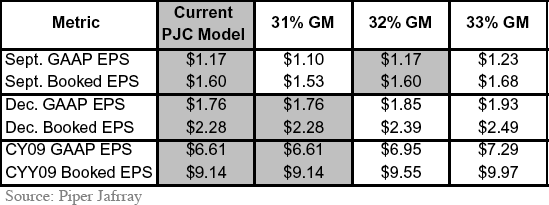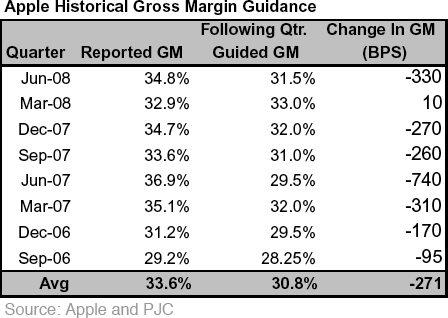The Cupertino-based company during a conference call in July guided its September quarter gross margin down 330 basis points sequentially to 31.5 percent, citing expected impact from a mysterious product transition, a full quarter of back-to-school promo sales, and a one time true-up with a manufacturing partner.
The lower-than-expected guidance was of immediate concern to investors, but as analyst Gene Munster points out in a new report Tuesday, the quarter has since ended and none of the company's actions seem to warrant such a drop-off in margins.
"Apple cited new, lower-margin products, but the only new products announced in the September quarter were new iPod nanos with higher capacities at the same prices and a 23 percent price cut on the iPod touch," he wrote. "Considering the decline in NAND Flash pricing has been at least in-line with typical seasonality, it is unlikely that these changes will result in a greater than average sequential GM decline."
In other words, Munster believes the falling cost of NAND flash memory — historically the most expensive component used in iPods — will offset any reductions in the retail price of the players instated by Apple.
As for the back-to-school promo, the analyst believes that Wall Street already has a concrete understanding of its effects, which have been communicated well over the years. That said, he believes the impact of this year's promo is being overestimated in terms of its hit on the company's bottom line, yet underestimated in terms of how many additional Macs it helped sell.
Therefore, Munster said he remains confident in his September quarter gross margin estimate of 32 percent, arguing that the conservative margin guidance offered by Apple management was simply a base case used to rein in Wall Street's ballooning expectations, and not an indication of how it expected the company to perform.
Apple also used the same conference call in July to guide down its margins for the entire 2009 fiscal year, which similarly served to rattle investors. The company, however, offered no reason the change other than saying upcoming product transitions will likely involve lower prices on existing products.
To Munster, this is clearly a signal that Apple will introduce new notebooks with at least one model coming in at sub-$1000 recession pricing. While such a move would clearly impact margins, it wouldn't be enough to drive them down to the 30 percent level, he said. Therefore, should the company guide margins for the December quarter down to 30 percent, it would again be seen as a conservative play. On the other hand, an absence of lower-priced Macs could prove detrimental to the company's shares.
"Importantly, we believe investors would see the lack of redesigned, lower-priced Macs as a more significant negative than they would a 30 percent GM guide in the December quarter," he argued. "Net-net, if Apple issues December GM guidance of 30 percent based on lower-priced Macs, the new Macs would be a positive for the stock."
Munster maintained his Buy rating on shares of Apple and held strong to his $250 12-month price target. He included with his report two charts (above), one of which estimates the company's per-share earnings sensitivity to various gross margin scenarios, while the other shows how the company has routinely guided down its margins for the past eight quarters only to smash those estimates when it reports results three months later.
 Katie Marsal
Katie Marsal








-m.jpg)






 Charles Martin
Charles Martin
 Marko Zivkovic
Marko Zivkovic
 Andrew Orr
Andrew Orr
 Amber Neely
Amber Neely

 William Gallagher and Mike Wuerthele
William Gallagher and Mike Wuerthele











23 Comments
that's nice analysis, a methodical approach instead of the unfounded speculation critics on these blogs sometimes accuse the analysts of.
still, investors should remember he's addressing only profit margins and their effects, and not declines in revenue. While higher volumes lead to higher margins, it's not a 1:1 relationship. Even if it were, a 32% margin for example, on $x in sales, isn't gonna yield anywhere near the profits of a 32% margin on 0.8 x $x in sales, should sales decline that much from the guidance. I'd have liked to have seen him tie his analysis of margins with an analysis of sales expectations.
I assumed the "product transition" referred to was the iPhone 3G, and that Apple's focus on selling them might offset Mac sales. Many Apple Stores seemed to spend the better part of a month (1/3 of the quarter) handling mostly iPhone 3G sales, potentially driving away Mac buyers. And since the iPhone 3G's quarterly impact is much less than a Mac sale, Apple could see a potential revenue hit.
However, it looks to me like a gangbuster back-to-school season more than offset any impact, and Apple is selling huge numbers of Macs through their University and direct channels to college folks. So I think the danger there is substantially less.
In addition, it feels (I have no actual information on this) that their ramp-up of new laptops is significantly behind schedule. Even taking into account the normal rumor-to-reality gap, it still seems like the laptop refresh should have come before October, and we still have no definite word of an Apple event. So this mysterious "product transition" could easily have been put off until next quarter, artificially raising this quarter's margins.
In addition, it feels (I have no actual information on this) that their ramp-up of new laptops is significantly behind schedule. Even taking into account the normal rumor-to-reality gap, it still seems like the laptop refresh should have come before October, and we still have no definite word of an Apple event. So this mysterious "product transition" could easily have been put off until next quarter, artificially raising this quarter's margins.
It's looking more and more like thats the case.
As for the back-to-school promo, the analyst believes that Wall Street already has a concrete understanding of its affects
You mean 'effects'.
I see target price ranging from $115 to $250. Who do you believe?